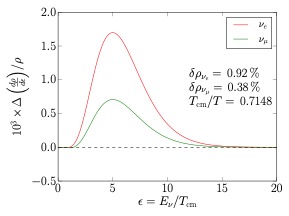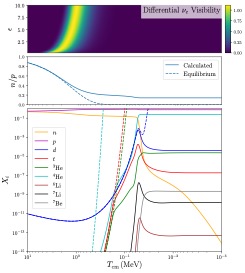Theoretical Nuclear and Elementary Particle Physics and Astrophysics and Cosmology.
Dark Matter.
General Relativity and Gravitational Waves.
The physics of the early universe and stars, nuclei and particles. The potential role of Beyond Standard Model (BSM) physics in the cosmos; The source or sources of Dark Matter, especially as regards the physics of the neutrino sector and dark sectors; General relativistic instability and gravitational collapse of massive and supermassive stars and associated nuclear and particle physics and gravitational waves. Primordial black holes and the origin of the supermassive black holes; The origin of nuclei, especially the light elements in the Big Bang and the heavy elements in supernovae and binary compact object mergers and the connections of this nucleosynthesis with the physics of the weak interaction and neutrinos, including BSM physics. A common theme running through much of Professor Fuller's work is the interplay of the weak interaction (neutrinos), atomic nuclei, and gravitation.
Ongoing Research Thrusts
We are exploring a whole new world. The existence of the Dark Side of the Universe (Dark Matter & Dark Energy) is one signal that the Standard Model of elementary particle physics is incomplete; developments in experimental neutrino physics provide another. Dark Matter may be rich in its phenomenology, perhaps involving whole new “dark sectors” of particles. Moreover, we have new observational and experimental probes that include gravitational wave (GW) observatories, multi-messenger astrophysics (e.g., electromagnetic signals plus particles and GWs), etc., along with a host of laboratory experiments, e.g., LHC, FRIB, and double beta decay and long- and short-baseline neutrino oscillation experiments. The neutrino experiments have already revealed neutrino properties (mass-squared differences, vacuum mixing angles, etc.) and promise many more (e.g., the ν-mass hierarchy, ν-sector CP-violation, the ν Majorana/Dirac character and possible lepton number violation, etc.). All of this physics can have profound implications for cosmology and compact object physics (i.e., the evolution and gravitational collapse of stars and the origin of black holes). Neutrino physics and astrophysics & cosmology, especially when coupled with nuclear physics & nucleosynthesis, may be one of our most promising portals to the Dark Side. My group and I work on many aspects of these issues.
Nonlinear Neutrino Flavor and/or Majorana Neutrino-Antineutrino (“spin”) Transformation
Neutrinos can dominate environments in the early universe and core collapse supernovae and binary neutron star mergers. The impact of these particles in transporting (in time/space) and depositing energy/entropy and in influencing composition (e.g., isospin) is flavor dependent and, consequently, we must be able to calculate neutrino flavor evolution in environments where the neutrino flavor field determines the potentials that dictate how neutrino flavor changes! This fiercely nonlinear, relativistic quantum many-body problem is vexing and very likely unique (i.e., at the frontier of elementary particle physics, condensed matter theory, and astrophysics).



Selected recent (and earlier!) representative papers :
“Resonant neutrino oscillations and stellar collapse”, G.M. Fuller, R.W. Mayle, J.R. Wilson, D.N. Schramm, The Astrophysical Journal 322, 795 (1987).
“Connection between flavor-mixing of cosmologically significant neutrinos and heavy element nucleosynthesis in supernovae”, Y.-Z. Qian, G.M. Fuller, G.J. Mathews, R.W. Mayle, J.R. Wilson, S.E. Woosley, Physical Review Letters 71, 1965 (1993).
“Neutrino-neutrino scattering and matter-enhanced neutrino flavor transformation in supernovae”, Y.-Z. Qian and G.M. Fuller, Physical Review D 68, 1479 (1995).
“Simulation of coherent nonlinear neutrino flavor transformation in the supernova environment: Correlated neutrino trajectories”, H. Duan, G.M. Fuller, M. J. Carlson, Y.-Z. Qian, Physical Review D 74, 105014 (2006).
“Collective neutrino oscillations”, H. Duan, G.M. Fuller, Y.-Z. Qian, Annual Review of Nuclear and Particle Science, 60, 569 (2010).
“Neutrino scattering and flavor transformation in supernovae”, J. Cherry, J. Carlson, A. Friedland, G.M. Fuller, A. Vlasenko, Physical Review Letters 108, 261104 (2012).
“Neutrino quantum kinetics”, A. Vlasenko, G.M. Fuller, V. Cirigliano , Physical Review D 89, 105004 (2014).
“A new spin on neutrino quantum kinetics”, V. Cirigliano, G.M. Fuller, A. Vlasenko, Physics Letter B, 747, 27 (2015).
“Geometric phases in neutrino oscillations with nonlinear refraction” L. Johns & G.M. Fuller, Physical Review D 95, 043003 (2017).
“Neutrino oscillations in supernovae: Angular moments and fast instabilities”, L. Johns, H. Nagakura, G.M. Fuller, A. Burrows , Physical Review D 101, 043009 (2020).
“Where when and why: Occurrence of fast-pairwise collective neutrino oscillation in three dimensional core collapse supernova models”, H. Nagakura, A. Burrows, L. Johns, G.M. Fuller, Physical Review D 104, 083025 (2021).
Dark Matter and Neutrino Cosmology
Neutrino rest mass represents BSM physics and it raises many possibilities, including the existence of right-handed “sterile” electroweak singlet states, or Dark Sector neutrinos. Active neutrino scattering-induced decoherence could produce these particles in both the early universe and in core collapse supernovae. The results could range from wreaking havoc on our models for these environments (good for constraining this physics!), all the way to a stealthy explanation of the Dark Matter. Our group proposed a key mechanism (resonant enhancement) to produce sterile neutrinos as Dark Matter, but also came up with the most sensitive way we have to probe and constrain this sector of particle physics (X-ray astronomy!). We continue to work on neutrino mass/mixing models and ways to constrain them in the lab and through astrophysical arguments.
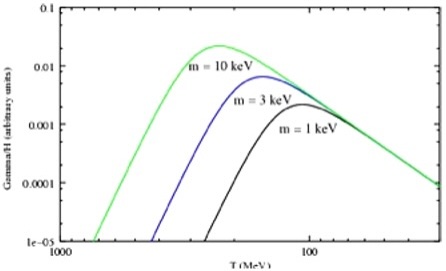
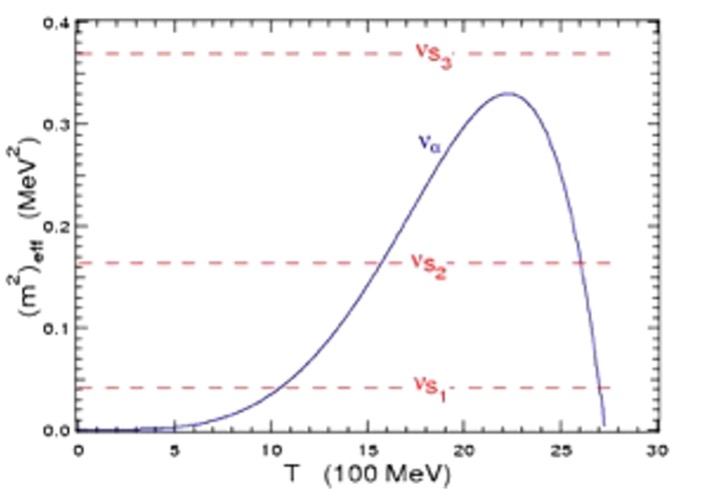


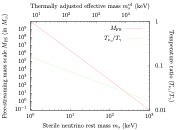
Selected recent (and earlier!) representative papers :
“New Dark Matter Candidate: Nonthermal Sterile Neutrinos”, X. Shi & G.M. Fuller, Physical Review Letters 82, 2832 (1999).
“Sterile neutrino hot, warm, and cold dark matter”, K. Abazajian, G.M. Fuller, M. Patel, Physical Review D 64, 023501 (2001).
“Direct Detection of Warm Dark Matter in the X-Ray”, K. Abazajian, G.M. Fuller, W.H. Tucker, The Astrophysical Journal, 562, 593 (2001).
“Lepton-number-driven sterile neutrino production in the early universe”, C.T. Kishimoto & G.M. Fuller, Physical Review D 78, 023524 (2008).
“Diluted equilibrium sterile neutrino dark matter”, A.V. Patwardhan, G.M. Fuller, C.T. KIshimoto, A. Kusenko, Physical Review D 92, 103509 (2015).
“Self-interacting sterile neutrino dark matter: The heavy-mediator case”, L. Johns & G.M. Fuller, Physical Review D 100, 023533 (2019).
“Effects of an intermediate mass sterile neutrino population on the early Universe” H. Rasmussen, A. McNichol, G.M. Fuller, C.T. Kishimoto, Physical Review D 105, 083517 (2022).
“Probing self-interacting sterile neutrino dark matter with the diffuse supernova neutrino background”, A.B. Balantekin, G.M. Fuller, A. Ray, A.M. Suliga, Physical Review D 108, 123011 (2023).
“Dark population transfer mechanism for sterile neutrino dark matter”, G.M. Fuller, L. Graf, A.V. Patwardhan, J. Spisak, arXiv:2402.1387, Physical Review Letters (in press 2024)
"Dark Matter and General Relativistic Instability in Supermassive Stars" K. Kehrer, G.M. Fuller, Physical Review D, in press (2024), arXiv:2406.13887
The Nuclear and Elementary Particle Physics of Gravitational Collapse
The weak interaction drives the evolution of stars and the creation of the elements. Neutrino emission refrigerates (reduces the entropy of) the cores of massive stars, setting them up for General Relativistic and other instabilities. These cores collapse at low entropy (~1 kb per baryon), with their baryonic component mostly locked up in ultra-heavy nuclei that sit at extreme excitation energy (e.g., > 20 MeV above the ground state). In roughly one second these cores collapse to nuclear density and form hot proto-neutron stars. The gravitational binding energy released in this collapse (10% of the rest mass of the core!) resides in degenerate seas of electrons and electron neutrinos and, ultimately, 99% of this energy appears as seas of neutrinos of all flavors. Understanding this phenomenon requires calculation of the weak interactions of these exotic high-excitation nuclei, as well as following neutrino interactions and flavor/energy/space/time transport (see above). Alluringly, much of this collapse physics is exquisitely sensitive to lepton number violating processes. We exploit that in order to explore BSM physics possibilities. That new physics, in turn, might be required to understand the dynamics of, and multi-messenger signals from, collapsing stars (and, by extension, merging binary neutron stars).
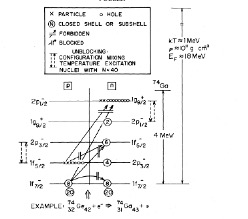


Selected recent (and earlier!) representative papers :
FULLER, FOWLER, NEWMAN (“FFN”) I,II,III,IV – high temperature and density nuclear charged current weak interactions – for example, FFNIII is:
“Stellar weak interaction rates for intermediate mass nuclei. III. Rate tables for the free nucleons and nuclei with A=21 to A=60”, G.M. Fuller, W.A. Fowler, M.J. Newman, The Astrophysical Journal Supplement Series, 48, 279 (1982).
“Neutron shell blocking of electron capture during gravitational collapse”, G.M. Fuller, The Astrophysical Journal 252, 741 (1982).
“The Majoron Model and Stellar Collapse”, G.M. Fuller, R.W. Mayle, J.R. Wilson, The Astrophysical Journal 332, 826 (1988).
“High-temperature neutrino-nucleus processes in stellar collapse”, G.M. Fuller, B.S. Meyer, The Astrophysical Journal 376, 701 (1991).
“Neutrino capture on heavy nuclei” G.C. McLaughlin & G.M. Fuller, The Astrophysical Journal 455, 202 (1995).
“Estimates of stellar weak interaction rates for nuclei in the mass range A=65-80”, J. Pruet & G.M. Fuller, The Astrophysical Journal Supplement Series 149, 1 (2003).
“Flavor changing supersymmetry interactions in a supernova” P.S. Amanik, G.M. Fuller, B. Grinstein, Astroparticle Physics 24, 160 (2005).
“Dark matter sterile neutrinos in stellar collapse: Alteration of energy/lepton number transport, and a mechanism for supernova explosion enhancement” J. Hidaka & G.M. Fuller, Physical Review D 74, 125015 (2006).
“Heavy sterile neutrinos and supernova explosions” G.M. Fuller, A. Kusenko, K. Petraki, Physics Letters B, 670, 281 (2009).
“Neutrino-pair emission from hot nuclei during stellar collapse”, G.W. Misch, B.A. Brown, G.M. Fuller, Physical Review C 88, 015807 (2013).
“Modification of the Brink-Axel hypothesis for high-temperature nuclear weak interactions”, G.W. Misch, G.M. Fuller, B.A. Brown, Physical Review C 90, 065808 (2014).
“Modified Brink-Axel hypothesis for astrophysical Gamow-Teller transitions” R.A. Herrera, C.W. Johnson, G.M. Fuller, Physical Review C 105, 015801 (2022).
“Neutrinos in Stellar Astrophysics” G.M. Fuller, W.C. Haxton, E.B. Grohs, The Encyclopedia of Cosmology: Set 2: Frontiers in Cosmology Volume 2, Neutrino Physics and Astrophysics, 367-431 (2024).
"Non-conservation of Lepton Numbers in the Neutrino Sector Could Change the Prospects for Core Collapse Supernova Explosions" A.M. Suliga, C.K. Cheong, J.Froustey, G.M. Fuller, L. Gráf, K.Kehrer, O.Scholer, S.Shalgar, submitted - Physical Review Letters (2024), arXiv:2410.01080
Black Holes and Gravitational Waves
Understanding the origin of the known inventory of black holes is challenging. GW observations are revolutionizing physics and astronomy and these provide new insights into this problem. The research directions outlined above, including those involving neutrinos, early universe and dark sectors, and nuclear physics are directly relevant to this challenge. At issue: (1) The origin of the supermassive black holes (> 106 solar masses) that exist at embarrassingly early epochs (e.g., 400 Myr) in the history of the universe; (2) The possible formation of primordial black holes (PBHs) in the early universe and the gravitational wave signals from formation processes, e.g., vacuum phase transitions; (3) Explanations of black holes in the putative “mass gaps”, i.e., light ones, < 2.5 solar mass, and heavy ones with ~ 80 solar masses that may be produced by non-exploding pair-instability progenitors; (4) Neutron star implosion via dark matter “ingestion” and associated signals, including r-process nucleosynthesis; (5) Effects of Dark Matter on stars and stellar stability.
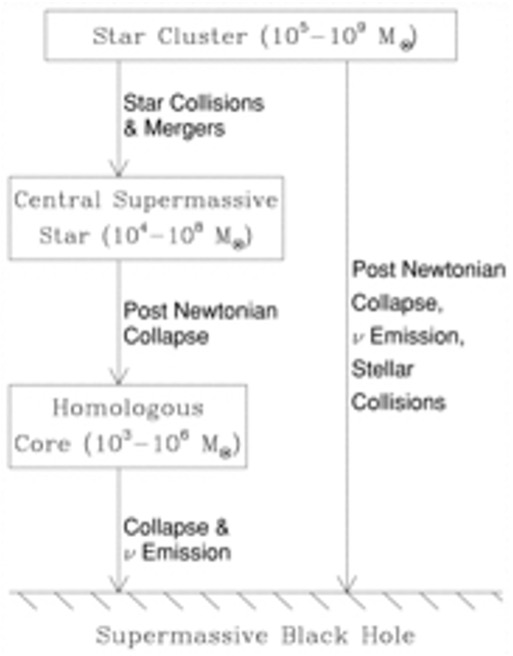
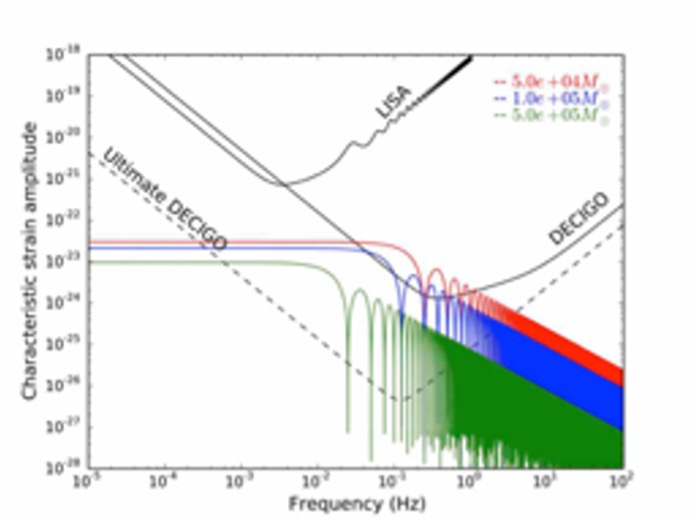
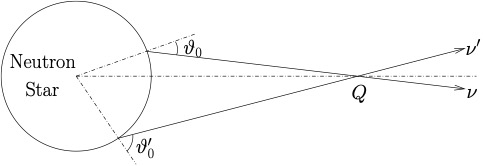
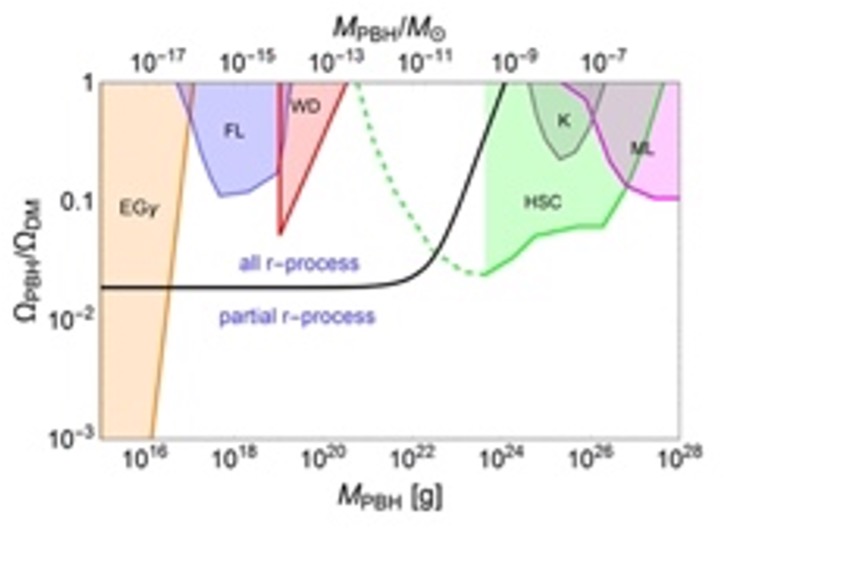
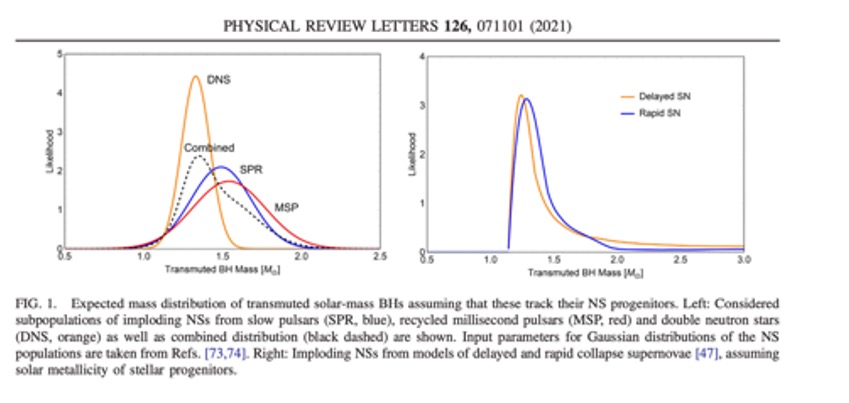
Selected recent (and earlier!) representative papers :
“The evolution of radiation-dominated stars. I-Nonrotating supermassive stars” G.M. Fuller, S.E. Woosley, T.A. Weaver, The Astrophysical Journal 307, 675 (1986).
“Effects of dark matter on the stability of supermassive stars” G.C. McLaughlin & G.M. Fuller, The Astrophysical Journal 456, 71 (1996).
“Neutrinos and supermassive stars: Prospects for neutrino emission and detection” X. Shi & G.M. Fuller, The Astrophysical Journal 503, 307 (1998).
“Observing the birth of supermassive black holes with the planned ICECUBE detector” X. Shi, G.M. Fuller, F. Halzen, Physical Review Letters 81, 5722 (1998).
“Neutrino burst-generated gravitational radiation from collapsing supermassive stars” J.T. Li, G.M. Fuller, C.T. Kishimoto, Physical Review D 98, 023020 (2018).
“Primordial Black Holes and r-Process Nucleosynthesis” G.M. Fuller, A. Kusenko, V. Takhistov, Physical Review Letters 119, 061101 (2017).
“Test for the origin of solar mass black holes” V. Takhistov, G.M. Fuller, A. Kusenko, Physical Review Letters 126, 071101 (2021).
“Exploring the origin of supermassive black holes with coherent neutrino scattering” V. Munoz, V. Takhistov, S.J. Witte, G.M. Fuller, Journal of Cosmology and Astroparticle Physics, 2021, 020 (2021).
“Signatures of a High Temperature QCD Transition in the Early Universe” P. Lu, V. Takhistov, G.M. Fuller, Physical Review Letters 130, 221002 (2023).
"Dark Matter and General Relativistic Instability in Supermassive Stars" K. Kehrer, G.M. Fuller, Physical Review D, in press (2024), arXiv:2406.13887
The QCD Epoch and Cosmic Vacuum Phase Transitions
The physics of the vacuum is at the frontier of both elementary particle physics and cosmology. The QCD transition is where chiral symmetry is broken and quarks and gluons are confined in color singlets (e.g., nucleons and mesons). In Standard Model physics, with the entropy-per-baryon s/kb = 5.9X109 (i.e., the value as measured by deuterium/BBN or the CMB acoustic peak amplitude ratios), the lattice-derived temperature of this event is Tc = 170 MeV and it is a cross-over, i.e., not a first order phase transition, so no phase separation. The causal horizon is then H-1 = (10 km) (50/g*)1/2( 100/Tc)2 and the corresponding total mass-energy inside this horizon is MH = (1 solar mass)(50/g*)1/2( 100/Tc)2. So, the causal horizon at this epoch contains a solar mass of nuclear density (overlapping color singlets!) stuff inside a radius of 10 km, i.e., it is an ultra-high entropy neutron star! Of immediate significance for cosmology, the statistical weight in relativistic particles, g*, at this epoch drops by a factor of 3. The resulting pressure drop makes any causal horizon more vulnerable to collapse to a black hole. BSM extensions of QCD can alter Tc and the order of the phase transition. We are actively investigating the implications of these BSM QCD extensions and other kinds of vacuum phase transitions for nucleated bubble collision-induced GWs. Moreover, as Witten showed in the mid 1980s , there could be an intimate connection between the QCD epoch and the later -decoupling/BBN epoch. Nucleosynthesis can be a sensitive probe of entropy inhomogeneity. We are also investigating vacuum phase transitions that take place much later in the history of the universe. These are “late phase transitions”, i.e., post photon decoupling. These could have implications for non-gaussian small scale structure, gravitational radiation (especially constraints in the nano-Hz band from the Pulsar Timing Array), early dark energy, and the formation of supermassive black hole seeds. Moreover, this physics could be related to BSM physics in the neutrino sector or dark sectors. Examples include late phase transitions associated with the generation of neutrino rest mass. Note that one thing we for sure share with a dark sector is gravitation (spacetime), so that vacuum phase transitions in a dark sector might well be a source of detectable gravitational waves.

Selected recent (and earlier!) representative papers :
“The quark-hadron phase transition and primordial nucleosynthesis” C. Alcock, G.M. Fuller, G.J. Mathews, The Astrophysical Journal 320, 439 (1987).
“Quark-hadron phase transition in the early universe: Isothermal baryon-number fluctuations and primordial nucleosynthesis” G.M. Fuller, G.J. Mathews, C.R. Alcock, Physical Review D 37, 1380 (1988).
“Coupled Baryon Diffusion and Nucleosynthesis in the Early Universe” G.J. Mathews, B.S. Meyer, C.R. Alcock, G.M. Fuller, The Astrophysical Journal 358, 36 (1990).
“Inhomogeneous Primordial Nucleosynthesis: Coupled Nuclear Reactions and Hydrodynamic Dissipation Processes” K. Jedamzik, G.M. Fuller, G.J. Mathews, The Astrophysical Journal 423, 50 (1994).
“Light element signatures of sterile neutrinos and cosmological lepton numbers” C.J. Smith, G.M. Fuller, C.T. Kishimoto, K.N. Abazajian, Physical Review D 74, 085008 (2006).
“Using Big Bang Nucleosynthesis to extend CMB probes of neutrino physics” M. Shimon, N.J. Miller, C.T. Kishimoto, C.J. Smith, G.M. Fuller, B.G. Keating, Journal of Cosmology and Astroparticle Physics 2010, 05, 037 (2010).
“New nuclear physics for big bang nucleosynthesis” R.N. Boyd, C.R. Brune, G.M. Fuller, C.J. Smith, Physical Review D 82, 105005 (2010).
“Neutrino energy transport in weak decoupling and big bang nucleosynthesis” E. Grohs, G.M. Fuller, C.T. Kishimoto, M.W. Paris, A. Vlasenko, Physical Review D 93, 083522 (2016). “The surprising influence of late charged current weak interactions on big bang nucleosynthesis” E. Grohs and G.M. Fuller, Nuclear Physics B 911, 955 (2016).
“Probing dark photons in the early universe with big bang nucleosynthesis” J.T. Li, , G.M. Fuller, E. Grohs, Journal of Cosmology and Astroparticle Physics (JCAP), 2020, (12) 049, (2020).
“Consequences of neutrino self-interactions for weak decoupling and big bang nucleosynthesis” E. Grohs, , G.M. Fuller, M. Sen, Journal of Cosmology and Astroparticle Physics (JCAP), 2020, (07) 001, (2020).
"Big Bang Nucleosynthesis" E. Grohs, G.M.Fuller, In: Tanihata, I., Toki, H., Kajino, T. (eds) Handbook of Nuclear Physics . Springer, Singapore. https://doi.org/10.1007/978-981-15-8818-1_127-1
“Cosmic Neutrino Decoupling and its Observable Imprints: Insights from Entropic-Dual Transport” J.R. Bond, G.M. Fuller, E. Grohs, J. Meyers, M.J. Wilson, Journal of Cosmology and Astroparticle Physics, Volume 2024, Issue 09, id.014, (2024), arXiv:2403.19038

